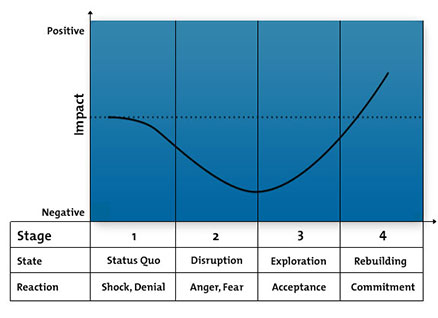So, I haven’t blogged for almost 6 months… I can’t believe it. Time flies when you’re having fun, but it unfortunately also flies when you’re dealing with upheaval. The last 6 months count among the most stressful times in my career. I’ve held a managerial position in a language and communication training organization for the last 5 years, and we recently lost a big customer. I say big – it was over half our business. It’s threatened jobs, caused an awful lot of lost sleep, and changed the entire way our company works. We had been restructuring the language programme for our customer according to their suggestions, but we hadn’t seen their decision to end the contract coming. At first we were shell-shocked and couldn’t think straight. Next came the bitterness and ill-feeling – how could they??? After that came acceptance – we can’t do anything to reverse their decision, so we’d better deal with it, quickly. And, now we’ve come to terms with the change and have come up with an action plan – we’re embracing the change and developing new and exciting concepts which are taking off slowly – but very steadily. Apparently these are typical reactions to change. According to research by Kubler-Ross, people demonstrate a fairly predictable set of emotions when changes take place, as you can see from the diagram below.
Change needs to be understood and managed in such a way that people can cope with it effectively. Organisations need to ensure that their staff understand what changes are being made and why. They also need to involve them in the change process, giving them an opportunity to influence the change. Face-to-face communication and dealing with questions and concerns sensitively is essential. I’ve spent the last few months trying to support my colleagues in a number of ways:
- Helping to communicate the reason for and implication of the changes to our trainers.
- Assessing the impact of this change on our business and its structure.
- Making sure trainers have help and support during times of uncertainty.
- Assessing training needs driven by the change, and defining when and how this will be implemented.
- Identifying success indicators for change, and making sure we regularly measure these.
And now, finally, my head’s just popped back above water… I’m still kicking my feet and I’m aware that the tide of change could pull us all back in again, but I’m quietly confident that we’ve dealt well with a sticky situation and things are on the up. I’ve prepared a lesson plan for anyone whose learners deal with change management – both reacting to change or actively implementing changes in the organisations where they work. It gets them talking about what change is and how it works, particularly in terms of how people react. You can find it here. If you find it useful, you can also try this lesson I wrote as a follow up, which guides learners on how to announce changes. As always feedback and comments are welcome, and if you’re subject to any changes at the moment, then I hope they’re all exciting ones!
